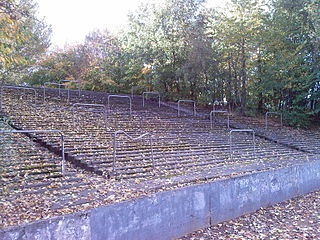
Cathkin Park is a municipal park in Glasgow, Scotland. The park is maintained by the city's parks department, and it is a public place where football is still played. The park contains the site of the second Hampden Park, previously home to the football clubs Queen's Park and Third Lanark. The site of the original Hampden Park is just to the west.
Abercorn Football Club was a football club based in Paisley, Scotland. The club were members of the Scottish Football League from 1890 until 1915 and folded in 1920. Abercorn were founder members of the Scottish Football League, but eventually could not compete with local rivals St Mirren. During their time in the SFL the club played at Underwood Park, Old Ralston Park and New Ralston Park. Their colours were blue and white stripes.
King's Park Football Club were a football club who played in the Scottish Football League (SFL) before the Second World War. Based in Stirling, they joined the League in the 1921–22 season, following the reintroduction of the Second Division and were one of 11 new members for that season.
Renton Football Club was a football club based in Renton, West Dunbartonshire, Scotland. Formed in 1872, they were a prominent team in the early history of Scottish football, and were one of the teams that featured in the first ever Scottish Cup fixture. They won the competition twice, in 1885 and 1888, and were also runners-up three times. Their 6–1 win against Cambuslang in 1888 is the joint record win in a Scottish Cup final.
Linthouse Football Club was a football club from the Linthouse district of Govan, Scotland. The club played in navy blue.
Cambuslang Football Club was a Scottish football club, based in the Cambuslang area. Cambuslang was one of the founding members of the Scottish Football League, but left the league after just two seasons.
Tontine Park was a football ground in Renton, West Dunbartonshire, Scotland. It was the home ground of Renton F.C. from 1878 until 1922, including their time in the Scottish Football League.

Millburn Park is a football ground in Alexandria, Scotland. It has been the home ground of Vale of Leven since 1888, hosting Scottish Football League matches between 1890 and 1926.
Westmarch was a football stadium located on Greenhill Road in Ferguslie Park, Paisley, Scotland. It was the home ground of St Mirren from 1883 to 1894.
The Athletic Grounds was a sports ground in Blackpool, England. It was the home ground of Blackpool F.C. between 1897 and 1898, and it was the 55th ground to host a Football League game.
Raikes Hall was a football ground in Blackpool, Lancashire, England. It was the home ground of Blackpool F.C. between 1888 and 1899.
Wellington Road was a football ground in the Perry Barr area of Birmingham, England. It was the home ground of Aston Villa from 1876 until 1897.
Springvale Park was a football ground in the Cowlairs area of Glasgow, Scotland. It was the home ground of Cowlairs F.C. during their time in the Scottish Football League.
Cathkin Park was a football ground in the Crosshill area of Glasgow, Scotland. It was the home ground of Third Lanark from their foundation in 1872 until they moved to New Cathkin Park in 1903. It also hosted Scottish Cup final matches and the Scotland national team.
Dunterlie Park is a football ground in Barrhead, Scotland. The third stadium to bear the name, it is the home ground of Arthurlie.
Raploch Park, also known as the Larkhall Greyhound Stadium, was a football ground and greyhound racing stadium in Larkhall, Scotland. It was the home ground of Royal Albert.
Whitestone Park is a sports ground in Peebles, Scottish Borders, Scotland, used for football and cricket. It has been the home ground of Peebles Rovers F.C. since 1906, including when they were members of the Scottish Football League between 1923 and 1926. It is also used by Peebles County Cricket Club.
Celtic Park was a football ground in Glasgow, Scotland. It was the home ground of Celtic from 1888 until they moved to the site of the modern Celtic Park in 1892. The ground staged an international match between Scotland and Ireland in 1891.
Ibrox Park was a football ground in Ibrox, Scotland. It was the home ground of Rangers from 1887 until they moved to the adjacent second Ibrox in 1899. The ground staged the Scottish Cup Final four times and also three Scotland international matches.
Cambuslang Hibernian F.C., also known as the Cambuslang Hibs, was a football club based in the town of Cambuslang, Scotland which was founded in 1884 and dissolved in 1908. They competed in regional competitions and the Scottish Cup during the 1880s, and after turning Junior, they won the Scottish Junior Cup in 1896.


